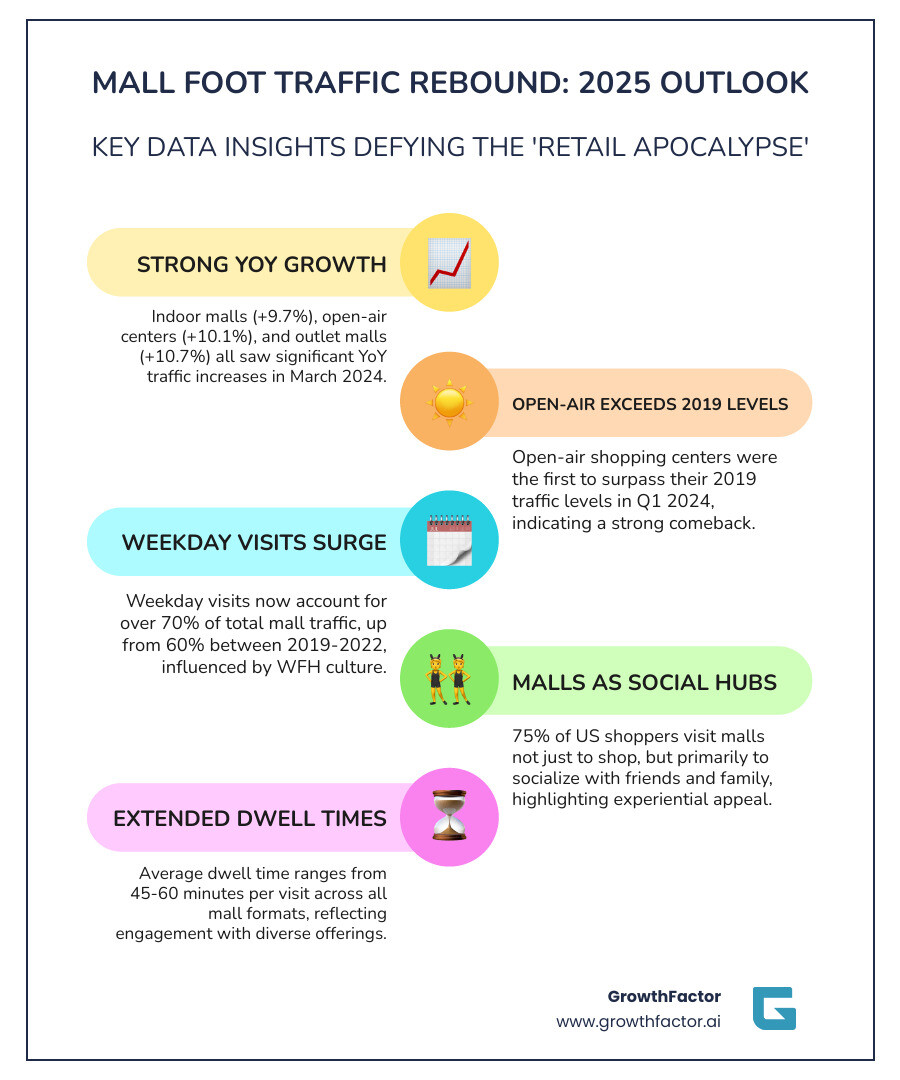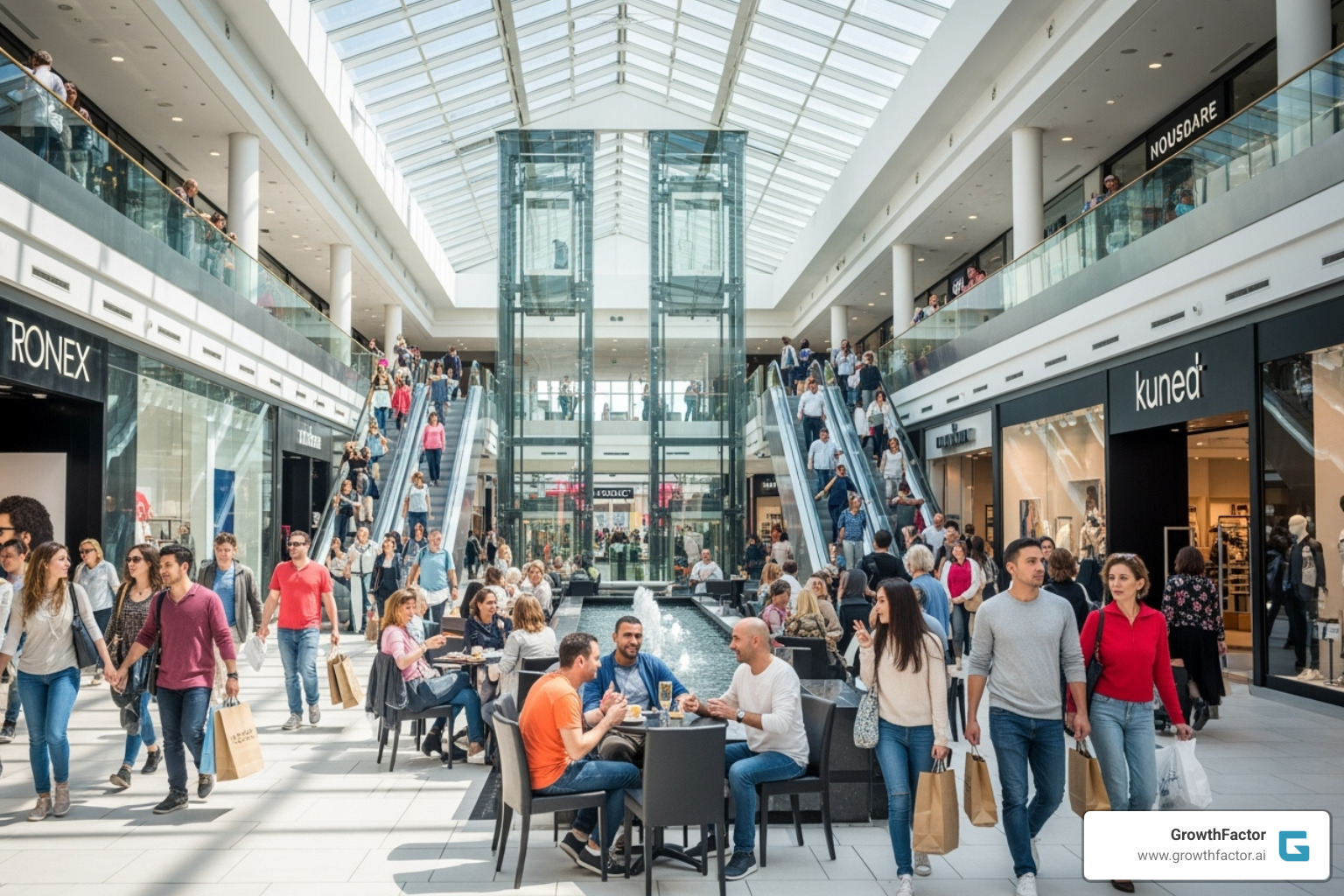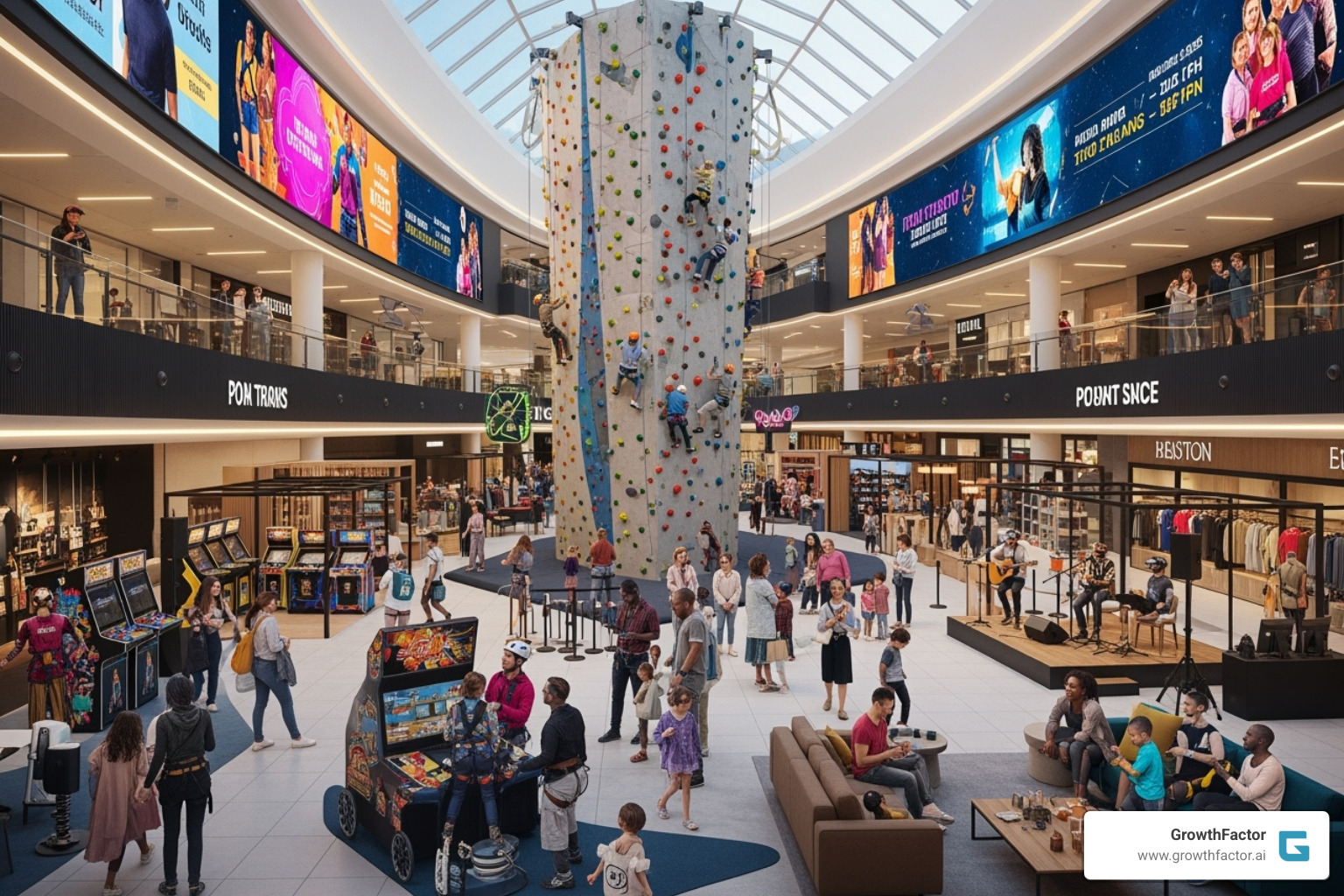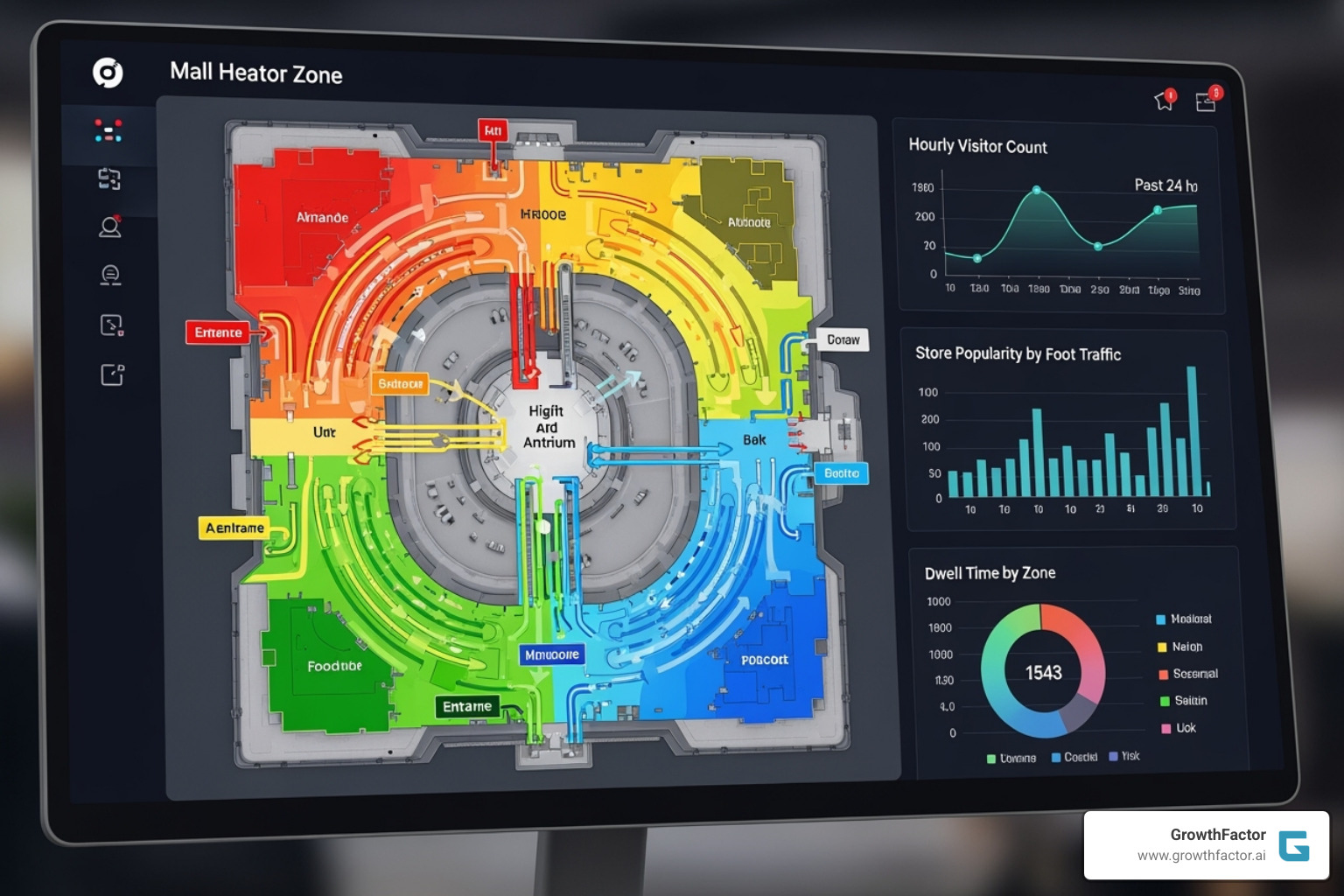Shopping Mall Foot Traffic: Your 2025 Outlook and Beyond
The Myth of the Mall Apocalypse
Mall foot traffic data reveals a surprising truth: the American shopping mall isn't dying—it's changing. Despite years of "retail apocalypse" predictions, recent data shows a remarkable recovery story unfolding across the United States.
Key Mall Foot Traffic Data Insights for 2025:
- Indoor malls: 9.7% year-over-year traffic increase (March 2024)
- Open-air shopping centers: 10.1% YoY growth, first to exceed 2019 levels in Q1 2024
- Outlet malls: 10.7% YoY increase despite economic headwinds
- Weekday visits: Rose from 60% to over 70% of total traffic between 2019-2022
- Average dwell time: 45-60 minutes per visit across all mall formats
- Weekend traffic: Still accounts for 65% of total mall visits
The data tells a compelling story of adaptation rather than decline. Malls are evolving into experiential destinations that blend shopping, dining, entertainment, and community spaces. The rise of work-from-home culture has shifted traffic patterns, with more visitors arriving during weekdays and earlier in the day.
Consumer behavior has fundamentally changed since 2019. Shoppers now treat malls as part of a larger outing, often combining visits with dining or other retail stops. This shift away from malls being a "one-stop-shop" actually signals resilience—malls are becoming integral parts of consumers' social and leisure activities.
For retail executives evaluating expansion opportunities, understanding these traffic patterns is crucial. The data shows that 75% of US shoppers visit malls not just to shop, but to socialize with friends and family. This behavioral shift creates new opportunities for retailers who can adapt their strategies accordingly.
I'm Clyde Christian Anderson, and my experience in retail real estate—from working in family retail operations to analyzing site selection data—has shown me how critical mall foot traffic data becomes when making expansion decisions. Today's successful retailers use this data not just to understand where customers are, but to predict where they're going next.

Mall foot traffic data glossary:
The State of Mall Foot Traffic in 2025: A Surprising Rebound
Remember when everyone said malls were doomed? Well, the mall foot traffic data coming in from 2025 tells a completely different story. We're not just seeing a small uptick here—we're witnessing a genuine comeback that's catching even industry veterans by surprise.
The numbers don't lie. After years of decline, shopping malls are experiencing their strongest performance since before the pandemic. This isn't some temporary holiday bump or seasonal fluke. We're looking at sustained growth that's reshaping how we think about physical retail spaces.
What makes this rebound so remarkable is its consistency across different mall formats. Whether you're talking about traditional enclosed malls, outdoor shopping centers, or outlet destinations, the trend is unmistakably upward. It's like watching a patient not just recover, but come back stronger than before.

Analyzing Current Trends vs. Previous Years
Let's explore the numbers that are making retail executives sit up and take notice. March 2024 delivered some eye-opening results: indoor malls jumped 9.7% compared to the same month in 2023, open-air shopping centers climbed 10.1%, and outlet malls surged an impressive 10.7%.
These aren't modest improvements—they're the kind of gains that signal a fundamental shift in consumer behavior. When I look at this data, I see shoppers refinding the value of physical retail experiences.
The first quarter of 2024 marked a turning point that many thought might never come. Open-air shopping centers actually exceeded their 2019 visitor levels for the first time since the lockdowns began. Think about that for a moment—we're not just talking about recovery, we're talking about growth beyond pre-pandemic levels.
What's particularly encouraging is how stable these numbers have remained despite economic uncertainty. Even when consumer confidence took a nosedive in February 2025, mall visits held steady year-over-year. That kind of resilience tells us that malls have found their footing in the new retail landscape.
The gap to pre-pandemic levels continues to narrow across all shopping center formats. Rising consumer sentiment numbers from Q1 2024 suggest we're finally putting the retail challenges of 2022 and 2023 behind us. Understanding these patterns through Foot Traffic Analytics gives retailers the insight they need to make smart expansion decisions.
Indoor Malls vs. Open-Air Centers vs. Outlet Malls
Not all malls are created equal, and the recovery data proves it. Each format brings something different to the table, attracting distinct shopper preferences and generating varying High Foot Traffic patterns.
| Mall Type | March 2024 YoY Growth | Q1 2024 vs. 2019 Levels | Average Dwell Time | Shopper Preference Insights |
|---|---|---|---|---|
| Indoor Malls | +9.7% | Nearing 2019 levels | ~60 minutes | Experiential, entertainment, diverse offerings. |
| Open-Air Shopping Centers | +10.1% | Exceeded 2019 levels | ~45 minutes | Outdoor appeal, convenience, post-pandemic preference for open spaces. |
| Outlet Malls | +10.7% | Lagging slightly | ~60 minutes | Value-driven, susceptible to economic uncertainty; online/local alternatives. |
Open-air shopping centers are leading the pack, becoming the first mall format to surpass 2019 visitation levels. There's something about combining retail therapy with fresh air that really resonates with today's shoppers. The pandemic definitely shifted preferences toward outdoor spaces, and that trend is sticking around.
Indoor malls are finding their rhythm by doubling down on experiences you can't get online. With shoppers spending about 60 minutes per visit, these destinations are becoming entertainment hubs where shopping is just one part of a larger social experience.
Outlet malls present an interesting case. While they showed strong year-over-year growth in March 2024, they've been more sensitive to economic fluctuations. When money gets tight, shoppers might skip the drive to an outlet mall in favor of online deals or local discount options.
This variation in performance highlights why analyzing mall foot traffic data requires nuance. The overall trend is positive, but success depends on understanding what makes each format tick and how to position your retail strategy accordingly.
How New Consumer Habits are Reshaping Mall Visitation
Something fascinating is happening in America's shopping centers. The way we visit malls today looks completely different from how we shopped just five years ago. It's not just about grabbing what's on your list anymore—it's about how work-from-home culture, smartphone shopping, and changing social habits are creating entirely new patterns in mall foot traffic data.

The rise of omnichannel shopping has transformed malls into pickup points and showrooms as much as traditional retail spaces. Shoppers now research online, compare prices on their phones while standing in stores, and increasingly use services like Buy Online, Pickup in Store (BOPIS). This shift means mall visits are often more purposeful and efficient, but they're also part of a larger, more complex shopping journey.
What's particularly interesting is how these changes haven't killed mall visits—they've just reorganized them. Recent data shows that while shopping behaviors have evolved, the physical mall experience remains valuable to consumers. They're just approaching it differently.
The Rise of Weekday Visits and WFH Culture
Here's where things get really interesting. Remember when malls were basically ghost towns on Tuesday afternoons? Those days are long gone. The pandemic didn't just change where we work—it completely rewrote when we shop.
Between 2019 and 2022, mall foot traffic data reveals that weekday visits jumped from about 60% to over 70% of total mall traffic. Take the Mall of America, for example. In 2019, only about 56% of visits happened on weekdays. By 2022, that number had climbed to roughly 70%. That's not a small shift—that's a fundamental change in how Americans structure their weeks.
The timing has shifted too. Before the pandemic, most weekday mall visitors arrived between noon and 6 p.m., with that classic lunch-hour peak. Now? People are showing up earlier, with higher traffic between 9 a.m. and noon. This creates incredible opportunities for breakfast spots, coffee shops, and service businesses that can cater to this new morning crowd.
For mall operators and retailers, this shift is golden. Weekdays used to be about keeping the lights on until the weekend rush. Now they're prime real estate for reaching customers who have flexible schedules and potentially more time to browse. Our AI Location Intelligence tools help businesses identify these new peak periods and adjust their operations accordingly.
The work-from-home culture has essentially given people permission to integrate errands and leisure activities into their weekdays. A quick mall run between Zoom calls? Why not. Meeting friends for lunch on a Wednesday? Absolutely. This flexibility has breathed new life into weekday mall operations.
The Impact of Holidays and Special Events
Holiday shopping patterns tell another fascinating story about changing consumer habits. The traditional Black Friday madness—those images of people camping outside stores and rushing through doors at dawn—is becoming more of a historical curiosity than a current reality.
Our Real-Time Foot Traffic data shows that Black Friday's dominance over the entire Thanksgiving weekend has mellowed significantly. Instead of one massive spike, we're seeing traffic spread more evenly across the four-day weekend. Thanksgiving Day mall visits have virtually disappeared, and the extreme peaks have smoothed into more manageable flows.
But don't think holidays have lost their power. Valentine's Day 2025 brought a notable surge in mall visits, particularly in the evening hours across all mall types. This highlights something important: malls aren't just shopping destinations anymore—they're date night locations, entertainment hubs, and social gathering spaces.
The post-holiday period in January consistently drives significant traffic increases. Returns and exchanges, end-of-season sales, and New Year fitness resolutions all contribute to busy mall corridors well into the new year. Smart mall operators and retailers use this predictable pattern to plan targeted promotions and ensure adequate staffing.
What's emerging is a more nuanced relationship between special events and mall visits. Rather than just shopping-focused rushes, we're seeing event-driven traffic that combines retail with dining, entertainment, and socializing. This shift reinforces the mall's evolution from a shopping center to a community destination.
The Mall Reborn: Strategies Driving the Comeback
The resilience we're seeing in mall foot traffic data isn't happening by accident. Smart mall operators have rolled up their sleeves and completely reimagined what a shopping center can be. Instead of clinging to outdated models, they're embracing change and creating spaces that feel fresh, relevant, and genuinely exciting to visit.

The most successful malls today understand a fundamental truth: they're no longer competing just with other retail spaces—they're competing with Netflix, restaurants, gyms, and every other way people choose to spend their free time. That's why the smartest operators are changing their properties into destinations worth the trip.
The Power of Experiential Retail
Here's what caught my attention in recent mall foot traffic data: 75% of US shoppers now visit malls primarily to socialize with friends and family. Shopping has become secondary to the experience itself. This shift has opened up incredible opportunities for malls willing to think beyond traditional retail.
The most successful properties are weaving entertainment directly into their DNA. Cinemas remain anchor tenants, but we're also seeing interactive arcades, escape rooms, and even indoor rock climbing walls. These aren't just add-ons—they're traffic drivers that keep people in the mall longer and give them reasons to return.
Dining has evolved from basic food courts to legitimate culinary destinations. Upscale restaurants, trendy cafes, and specialty food vendors are creating their own draw. When people plan an evening out, these malls have positioned themselves as viable options alongside traditional entertainment districts.
The genius lies in creating what I call "Instagrammable moments"—experiences that naturally encourage social sharing. A stunning art installation, a unique pop-up shop, or an interactive display doesn't just entertain visitors; it turns them into organic marketers for the property.
For retailers considering expansion, partnering with malls that prioritize experiential offerings makes strategic sense. Our Retail Store Expansion Strategy research shows these properties consistently deliver higher foot traffic and longer dwell times—exactly what growing brands need.
From Shopping Center to Community Hub
The most forward-thinking malls are taking this evolution even further. They're becoming genuine community hubs that serve multiple aspects of daily life. This isn't just about adding a few services—it's about fundamentally rethinking what a mall can be.
Fitness and wellness services are proving particularly effective. Gyms, yoga studios, and health clinics bring consistent weekday traffic and help balance the traditional weekend shopping rush. These tenants create regular visitors who often grab coffee, run errands, or meet friends while they're already at the mall.
Coworking spaces tap into the work-from-home trend we discussed earlier. Remote workers need occasional escapes from home offices, and malls with reliable WiFi, comfortable seating areas, and nearby dining options are filling this need perfectly.
Some properties are getting even more creative. Residential units above retail spaces create built-in foot traffic, while distribution centers tucked into former anchor spaces serve the growing demand for local fulfillment. These mixed-use approaches ensure activity throughout different times of day and week.
The results speak for themselves. Properties that successfully transition to community hubs see more stable occupancy rates and can command higher rents from tenants who benefit from the consistent foot traffic.
Our Retail Site Selection Analysis consistently shows that retailers in these reimagined spaces outperform those in traditional shopping centers. The key is identifying which malls are genuinely changing versus those just making cosmetic changes.
This change requires vision and investment, but the mall foot traffic data proves it works. Malls that accept their role as community gathering places aren't just surviving—they're thriving in ways that seemed impossible just a few years ago.
Leveraging Mall Foot Traffic Data for Smarter Operations
The days of running malls on gut instinct are over. Today's successful mall operators rely on mall foot traffic data to make informed decisions that drive profitability and improve the shopping experience. Think of it as having a crystal ball that shows you exactly how visitors move through your space, when they arrive, and what catches their attention.

Advanced footfall counter systems transform raw visitor counts into actionable intelligence. Instead of wondering why certain areas feel empty while others buzz with activity, you get clear answers backed by data. This isn't just about counting heads—it's about understanding the story those numbers tell about your space.
Our Foot Traffic Analysis Complete Guide dives deeper into how this data becomes the foundation for smarter mall management.
Optimizing Layouts, Marketing, and Staffing
Picture this: you find that the corridor near the food court sees three times more traffic than the area by the department store entrance. Mall foot traffic data reveals these patterns, helping you identify the hot spots where premium retailers thrive and the dead zones that need revitalization.
Smart layout optimization means placing high-draw tenants in areas that naturally attract crowds, while using anchor stores to guide traffic flow to quieter sections. When you know that 60% of visitors turn left after entering the main entrance, you can strategically position new stores or promotional displays to capitalize on that pattern.
Marketing becomes incredibly precise when you understand visitor rhythms. Instead of running promotions randomly, you can schedule events during peak hours when they'll reach the most people. That Valentine's Day campaign hits differently when you know evening visits spike by 15% during the week leading up to the holiday.
Staffing efficiency improves dramatically with traffic insights. The average visitor spends about 60 minutes in a shopping mall, but they don't arrive evenly throughout the day. Mall foot traffic data shows exactly when those 90 million annual visitors show up, allowing you to match staffing levels to actual demand. No more overstaffing during slow Tuesday mornings or scrambling to cover busy Saturday afternoons.
This level of optimization is exactly what our AI-Powered Retail Analytics solutions deliver—turning data into operational excellence.
Using Mall Foot Traffic Data to Improve Tenant Mix and Pricing
Here's where mall foot traffic data becomes a game-changer for the bottom line. When you can tell a prospective tenant that 15,000 people walk past their proposed location every week, rent negotiations become conversations about value rather than arguments about cost.
Data-driven rent negotiations eliminate guesswork. Premium locations near food courts or main entrances naturally command higher rents—sometimes reaching $29 per square foot monthly in prime markets. But now you have the numbers to justify those rates. Tenants see the value when you show them concrete visitor counts and traffic patterns.
Strategic tenant placement becomes an art backed by science. If your data shows that shoppers frequently move between the electronics store and the coffee shop, placing a bookstore along that path creates a natural flow that benefits all three businesses. With the average mall housing 120 stores, getting these relationships right makes a huge difference.
Revenue optimization through better tenant relationships pays off significantly. When you share valuable insights about peak hours, popular routes, and visitor demographics with your tenants, you're not just collecting rent—you're partnering for mutual success. Tenants who understand their foot traffic patterns can optimize their own operations, leading to higher sales and more stable lease agreements.
The numbers speak for themselves: malls using advanced retail footfall counters can increase leasing revenues by up to 20%. With average annual sales per square foot in US shopping malls at $481, that revenue boost translates to substantial improvements in profitability.
Our AI Lease Management solutions streamline this entire process, helping you turn foot traffic insights into stronger tenant relationships and better financial performance.
Conclusion: The Future of Malls is Data-Driven
The story told by mall foot traffic data isn't one of decline—it's a tale of remarkable adaptation. The American shopping mall has proven its resilience, evolving from a simple retail destination into something far more dynamic and community-centered.
What we've witnessed is nothing short of a retail revolution. Malls are embracing their role as experiential destinations where shopping blends seamlessly with dining, entertainment, and social connection. The shift toward mixed-use developments incorporating everything from coworking spaces to wellness centers shows just how far this evolution has come.
The numbers don't lie. With open-air centers exceeding 2019 levels and indoor malls showing consistent year-over-year growth, the data paints a picture of recovery and reinvention. The rise in weekday visits—jumping from 60% to over 70% of total traffic—reflects how malls have adapted to our new work-from-home reality.
But here's what's really exciting: understanding visitor behavior is the key to success in this new landscape. Mall operators who leverage advanced analytics can optimize everything from tenant placement to staffing schedules. They're seeing leasing revenue increases of up to 20% simply by making smarter, data-driven decisions.
The future belongs to those who can read the signals hidden in foot traffic patterns. Whether it's identifying the perfect spot for a new restaurant or understanding when to schedule promotional events, data is essential for adaptation in today's retail environment.
This is where AI-driven analytics become crucial for navigating the new retail landscape. The malls thriving today aren't just lucky—they're smart. They use sophisticated tools to understand their visitors' journeys and create experiences that keep people coming back.
At GrowthFactor, we've seen how the right insights can transform retail real estate decisions. Our platform helps turn complex visitor patterns into clear, actionable strategies that drive real results.
Ready to master the new era of mall management? Find how our All-in-One Real Estate Platform for Retail can help you master the new era of mall management. Let's turn your mall foot traffic data into your competitive advantage.
Citations
The human algorithm
Request Your demo
Schedule meeting
Or submit your information below and we'll be in touch to schedule.



